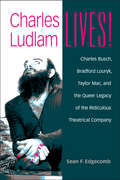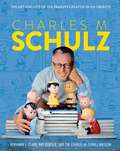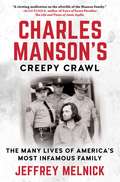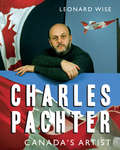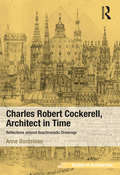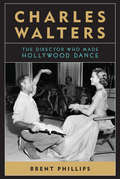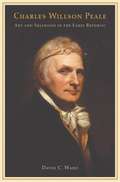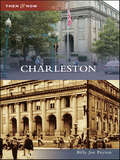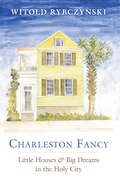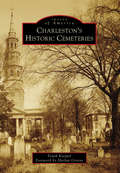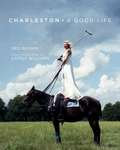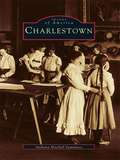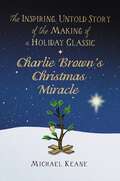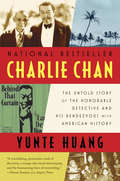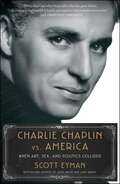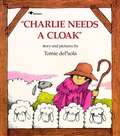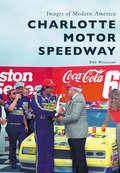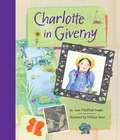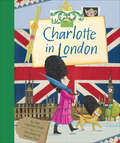- Table View
- List View
Charles Ludlam Lives!: Charles Busch, Bradford Louryk, Taylor Mac, and the Queer Legacy of the Ridiculous Theatrical Company
by Sean EdgecombPlaywright, actor and director Charles Ludlam (1943–1987) helped to galvanize the Ridiculous style of theater in New York City starting in the 1960s. Decades after his death, his place in the chronicle of American theater has remained constant, but his influence has changed. Although his Ridiculous Theatrical Company shut its doors, the Ludlamesque Ridiculous has continued to thrive and remain a groundbreaking genre, maintaining its relevance and potency by metamorphosing along with changes in the LGBTQ community. Author Sean F. Edgecomb focuses on the neo-Ridiculous artists Charles Busch, Bradford Louryk, and Taylor Mac to trace the connections between Ludlam’s legacy and their performances, using alternative queer models such as kinetic kinship, lateral historiography, and a new approach to camp. Charles Ludlam Lives! demonstrates that the queer legacy of Ludlam is one of distinct transformation—one where artists can reject faithful interpretations in order to move in new interpretive directions.
Charles M. Schulz: The Creator of PEANUTS in 100 Objects
by Nat Gertler The Charles M. Schulz Museum Benjamin L. ClarkCharles M. Schulz: The Life and Art of the Creator of Peanuts in 100 Objects explores the man behind one of America&’s most iconic comic strips and its beloved cast of characters—Charlie Brown, Snoopy, and the rest of the Peanuts Gang. Through 100 preserved and cataloged artifacts, delve into Charles M. Schulz&’s Minnesota youth in 1920s America, Schulz&’s WWII Army service, and Schulz&’s path to fame through his post-war comic series Li&’l Folks and five decades of Peanuts. From Schulz&’s first published drawing featured in Ripley&’s Believe It or Not! to his 2001 Congressional Gold Medal, the 100 artifacts bring the details of the singular artist to life. Along with provocative, witty, and wise quotes, fan-favorite strips, and more, this book is a must-have for any Peanuts fan. 100 OBJECTS: Carefully curated artifacts from Charles M. Schulz&’s home and studio—including medals and awards, family photos, rare comic art, and more—tell the story of this beloved artist&’s life, career, and the times in which he lived. EXPLORE AMERICANA: From his youth in 1920&’s Minnesota through the turbulent 60s and beyond, Charles Schulz&’s life spans the rich history of the American Century. CLASSIC STRIPS: Includes timeless Peanuts comic strips featuring Charlie Brown, Snoopy, and the whole Peanuts Gang. FASCINATING FACTS: Fans of Peanuts will find never-before-seen items that give them an intimate look at the creation of the acclaimed comic strip series. OFFICIAL ACCOUNT: Created in collaboration with the Charles M. Schulz estate, the book provides an exclusive look into the life of one of America&’s most revered artists.
Charles Manson's Creepy Crawl: The Many Lives of America's Most Infamous Family
by Jeffrey MelnickWith a new epilogue updated from its hardcover edition titled Creepy Crawling: Charles Manson and the Many Lives of America's Most Infamous Family "Creepy crawling" was the Manson Family's practice of secretly entering someone's home, and without harming anyone, leaving only a trace of evidence that they had been there, some reminder that the sanctity of the private home had been breached. Now, author Jeffrey Melnick reveals just how much the Family creepy crawled their way through Los Angeles in the sixties and then on through American social, political, and cultural life for fifty years, firmly lodging themselves in our minds. Even now, it is almost impossible to discuss the sixties, teenage runaways, sexuality, drugs, music, California, or even the concept of family without referencing Manson and his "girls." Not just another Charles Manson history, Charles Manson's Creepy Crawl: The Many Lives of America's Most Infamous Family explores how the Family weren't so much outsiders as emblematic of the Los Angeles counterculture freak scene, and how Manson worked to connect himself to the mainstream of the time. Ever since they spent two nights killing seven residents of Los Angeles—what we now know as the "Tate-LaBianca murders"—the Manson family has rarely slipped from the American radar for long. From Emma Cline's The Girls to the TV show Aquarius, as well as two major films in 2019, including Quentin Tarantino's Once Upon a Time in Hollywood, the family continues to find an audience. What is it about Charles Manson and his family that captivates us still? Author Jeffrey Melnick sets out to answer this question in this fascinating and compulsively readable cultural history of the Family and their influence from 1969 to the present.
Charles Pachter: Canada's Artist
by Margaret Atwood Tom Smart Leonard WiseAn Officer of the Order of Canada, Chevalier of France’s Order of Arts and Letters, and recipient of the Order of Ontario, painter, printmaker, sculptor, designer, and author, Charles Pachter is one of Canada’s best-loved and most celebrated artists. Pachter is an artist with an astonishing range. His work is witty, thoughtful, moving, and personal. Many works, like Queen on Moose, The Painted Flag, and Hockey Knights in Canada, have achieved a remarkable level of recognition, becoming famous across the country — indeed, around the world. His collaboration with Margaret Atwood on The Journals of Susanna Moodie has been called “truly the most magnificent book ever to be published in Canada.” Charles Pachter: Canada’s Artist is a celebration of the life and work — the struggles and triumphs — of a man who has helped to redefine Canadian art. Pachter’ promotion of Canada and its culture has left a lasting legacy — one that he continues to build on.
Charles Robert Cockerell, Architect in Time: Reflections around Anachronistic Drawings
by Anne BordeleauSpeed, acceleration and rapid change characterize our world, and as we design and construct buildings that are to last at least a few decades and sometimes even centuries, how can architecture continue to act as an important cultural signifier? Focusing on how an important nineteenth-century architect addressed the already shifting relation between architecture, time and history, this book offers insights on issues still relevant today-the struggle between imitation and innovation, the definition (or rejection) of aesthetic experience, the grounds of architectural judgment (who decides and how), or fundamentally, how to act (i.e. build) when there is no longer a single grand narrative but a plurality of possible histories. Six drawings provide the foundation of an itinerary through Charles Robert Cockerell’s conception of architecture, and into the depths of drawings and buildings. Born in England in 1788, Cockerell sketched as a Grand Tourist, he charted architectural history as Royal Academy Professor, he drew to build, to exhibit, to understand the past and to learn from it, publishing his last work in 1860, three years before his death. Under our scrutiny, his drawings become thresholds into the nineteenth century, windows into the architect’s conception of architecture and time, complex documents of past and projected constructions, great examples that reveal a kinetic approach to ornamentation, and the depth of architectural representation.
Charles Sheeler: Modernism, Precisionism and the Borders of Abstraction
by Mark RawlinsonCharles Sheeler was the stark poet of the machine age. Photographer of the Ford Motor Company and founder of the painting movement Precisionism, he is remembered as a promoter of - and apologist for - the industrialised capitalist ethic. This major new rethink of one of the key figures of American modernism argues that Sheeler's true relationship to progress was in fact highly negative, his 'precisionism' both skewed and imprecise. Covering the entire oeuvre from photography to painting and drawing attention to the inconsistencies, curiosities and 'puzzles' embedded in Sheeler's work, Rawlinson reveals a profound critique of the processes of rationalisation and the conditions of modernity. The book argues finally for a re-evaluation of Sheeler's often dismissed late work which, it suggests, may only be understood through a radical shift in our understanding of the work of this prominent figure.
Charles Walters: The Director Who Made Hollywood Dance (Screen Classics)
by Brent PhillipsA &“lively biography&” of the director who choreographed Fred Astaire, Debbie Reynolds and more: &“a real backstager&” on the making of Hollywood musicals (Wall Street Journal). From the trolley scene in Meet Me in St. Louis to Fred Astaire and Ginger Rogers's last dance on the silver screen to Judy Garland's tuxedo-clad performance of "Get Happy", Charles Walters staged the iconic musical sequences of Hollywood's golden age. The Academy Award-nominated director and choreographer showcased the talents of stars such as Gene Kelly, Doris Day, and Frank Sinatra—yet Walters's name often goes unrecognized today. In the first full-length biography of Walters, Brent Phillips chronicles the artist's career from his days as a Broadway performer to his successes at Metro-Goldwyn-Mayer. Phillips takes readers behind the scenes of beloved musicals including Easter Parade, Lili, and High Society. He also examines the director's uncredited work on films like Gigi, and discusses his contributions to musical theater and American popular culture. This revealing book also considers Walters's personal life and explores how he navigated the industry as an openly gay man. Drawing on unpublished oral histories, correspondence, and new interviews, this biography offers an entertaining and important new look at an exciting era in Hollywood history.
Charles Willson Peale: Art and Selfhood in the Early Republic
by David C. Ward Charles Willson PealeA biographical interpretation of the important but under-examined figure Charles Willson Peale (1741-1827), an early American famous as an artist, inventor, naturalist, patriot, and patriarch.
Charleston (Then and Now)
by Billy Joe PeytonCharleston, West Virginia, became a center of government, industry, and commerce after 1885, as people flocked to the city for work, shopping, and entertainment. Though much has changed over the years, Charleston�s past still matters. A respect for history binds together current and future residents.
Charleston Fancy: Little Houses and Big Dreams in the Holy City
by Witold RybczynskiA captivating chronicle of building in modern-day Charleston, making a case for architecture based on historical precedent, local context, and the ability to delight Charleston, South Carolina, which boasts America’s first historic district, is known for its palmetto-lined streets and picturesque houses. The Holy City, named for its profusion of churches, exudes an irresistible charm. Award-winning author and cultural critic Witold Rybczynski unfolds a series of stories about a group of youthful architects, builders, and developers based in Charleston: a self-taught home builder, an Air Force pilot, a fledgling architect, and a bluegrass mandolin player. Beginning in the 1980s, this cast of characters, exercising a kind of amateur mastery, produced an eclectic array of buildings inspired by the past—including a domed Byzantine drawing room, a fanciful medieval castle, a restored freedman’s cottage, a miniature Palladian villa, and a contemporary Mediterranean street. In his careful profiles of these protagonists and the challenges they have overcome in realizing their dreams, Rybczynski compellingly emphasizes the importance of architecture and urban design on a local level, how an old city can remake itself by invention as well as replication, and the role that individuals still play in transforming the urban landscapes around them.
Charleston Interiors (Dover Architecture)
by Samuel Chamberlain Narcissa ChamberlainThis splendid pictorial survey depicts 51 historic homes of Charleston, South Carolina. Over 300 photographs, accompanied by descriptive text, depict exquisite 18th- and 19th-century houses and their interiors. Includes illustrations of Ashley Hall, Crayton Hall, the Joseph Manigault house, as well as the homes of Colonel William Rhett, John Edwards, Charles Pinckney, and others.
Charleston's Historic Cemeteries (Images of America)
by Harlan Greene Frank KarpielWhen Charleston's founders moved their settlement across the Ashley River to the peninsula in 1680, they hoped for protection from pirate and Native American attacks, as well as increased trade and healthier living conditions. Their first three wishes came true, but not the final one. Life in colonial Charles Towne was dangerous--epidemic diseases, primitive medical practices, and a harsh environment led to the early demise of rich and poor alike. The graveyards of churches and public burial grounds quickly filled. Today, Charleston's historic cemeteries are almost as common a sight downtown as the churches that define the city. These tree-shrouded glades invite tourists and residents to explore the resting places of Charleston's most illustrious and interesting personalities. Charleston's Historic Cemeteries offers a guided pictorial tour of the elaborate gravestones and elegant inscriptions dedicated to the famous and infamous, including William Rhett and his adversary, the pirate Stede Bonnet. With dozens of illustrated stories about the transformation of funerals, tombstones, and mourning customs in America during the past 300 years, the book details how Charleston became the home of a historically unique, city-wide gallery of mortuary sculpture.
Charleston: A Good Life
by Ned Brown Gately WillamsInspired by the legendary work of Slim Aarons, a photographic narrative tour of a beautiful, unique, historical city and the remarkable people who live there.Author Ned Brown kicks off the Good Life series with the story about what makes Charleston, South Carolina so desirable to its residents and the five million visitors who seek it out each year. This stunning coffee- table book features photographs by Gately Williams, whose work is regularly featured in Garden & Gun, Coastal Living, and other publications.With his signature ease, Brown profiles more than fifty “interesting Charlestonians, doing interesting things in a beautiful place.” Charleston: A Good Life highlights native Charlestonians and those who have made the southern Holy City their home during the past two decades. Some are wealthy, many not, but all enjoy the richness of a place that has been voted the best small city in the world by Travel + Leisure magazine.
Charlestown (Images of America)
by Anthony Mitchell SammarcoOriginally settled in 1629, Charlestown became well-known as the scene of the pivotal Revolutionary Battle of Bunker Hill, actually fought on Breed's Hill. Recovering from a devastating fire at the hands of the British soon after the battle, Charlestown went on to become a prosperous neighbor to Boston, eventually being annexed to the larger city in 1874. Today the city is enjoying a tremendous rebirth and the restoration of many of its important landmarks, such as the 1780 Warren Tavern.
Charley Weaver’s Letters from Mamma
by Cliff ArquetteFrom coast to coast more people are keeping their television sets on much later, more nights because of Cliff Arquette.A regular on NBC’s “Jack Paar Show” Cliff’s meteoric rise to fame among late evening watchers is the result of his portrayal of a likable old codger Charley Weaver, who hails from Mount Idy, and who reads side-splitting letters from his “Mamma.”These letters are a complete report on the doin’s in the old home town. Through the magic of television, and now the pages of this book, Charley’s “Mamma” has made real people out of Birdie Rodd, Grandpa Ogg, Elsie Krack, Dr. Beemish and all the others. Real people and normal people. Normal except that the darndest things happen to them!As Jack Paar says, “Charley Weaver is a witch. He knows more about comedy than anyone alive, which he isn’t….Old Charley not only gets laughs on a Monday night but he gets them all during Lent…even when we are playing to a convention of Martian undertakers who have just heard bad news. That’s witchcraft!”This book proves Jack Paar’s point.
Charlie Brown's Christmas Miracle: The Inspiring, Untold Story of the Making of a Holiday Classic
by Michael KeaneDiscover the inspiring, unknown, against-all-odds story of how the classic animated holiday special A Charlie Brown Christmas almost never made it on to television. Professor and cultural historian Michael Keane reveals much in this nostalgia-inducing book packed with original research and interviews. Keane compellingly shows that the ultimate broadcast of the Christmas special—given its incredibly tight five-month production schedule and the decidedly unfavorable reception it received by the skeptical network executives who first screened it—was nothing short of a miracle. Keane explains why the show, despite its technical shortcomings, has become an uplifting and enduring triumph embraced by millions of families every Christmas season, even more than fifty years after its premiere. This gripping and joyful behind-the-scenes story of how the creators of A Charlie Brown Christmas struggled to bring the program to life will also help readers (and loyal fans) understand how America&’s favorite Christmas special changed our popular culture forever. Keane masterfully weaves the momentous events of 1965 (the turbulent year of the program&’s production) into his story, providing critical context for a profound new understanding of the program&’s famous climactic scene, Linus&’s spot-lit soliloquy answering the question repeatedly posed by Charlie Brown—"Isn't there anyone who knows what Christmas is all about?&”
Charlie Chan: The Untold Story of the Honorable Detective and His Rendezvous with American History
by Yunte HuangShortlisted for the 2010 National Book Critics Circle Award in Biography and the 2011 Edgar Award for Best Critical/Biographical Book: "An ingenious and absorbing book. . . . It will permanently change the way we tell this troubled yet gripping story."--Jonathan Spence Hailed as "irrepressibly spirited and entertaining" (Pico Iyer, Time) and "a fascinating cultural survey" (Paul Devlin, Daily Beast), this provocative first biography of Charlie Chan presents American history in a way that it has never been told before. Yunte Huang ingeniously traces Charlie Chan from his real beginnings as a bullwhip-wielding detective in territorial Hawaii to his reinvention as a literary sleuth and Hollywood film icon. Huang finally resurrects the "honorable detective" from the graveyard of detested postmodern symbols and reclaims him as the embodiment of America's rich cultural diversity. The result is one of the most critically acclaimed books of the year and a "deeply personal . . . voyage into racial stereotyping and the humanizing force of story telling" (Donna Seaman, Los Angeles Times).
Charlie Chaplin vs. America: When Art, Sex, and Politics Collided
by Scott EymanThe &“shocking&” (The Wall Street Journal), must-read story of Charlie Chaplin&’s years of exile from the United States during the postwar Red Scare, and how it ruined his film career, from bestselling biographer Scott Eyman.Bestselling Hollywood biographer and film historian Scott Eyman tells the story of Charlie Chaplin&’s fall from grace. In the aftermath of World War II, Chaplin was criticized for being politically liberal and internationalist in outlook. He had never become a US citizen, something that would be held against him as xenophobia set in when the postwar Red Scare took hold. Politics aside, Chaplin had another problem: his sexual interest in young women. He had been married three times and had had numerous affairs. In the 1940s, he was the subject of a paternity suit, which he lost, despite blood tests that proved he was not the father. His sexuality became a convenient way for those who opposed his politics to condemn him. Refused permission to return to the US after a trip abroad, he settled in Switzerland and made his last two films in London. In Charlie Chaplin vs. America, Scott Eyman explores the life and times of the movie genius who brought us such masterpieces as City Lights and Modern Times. &“One of the finest surveys of the man and the artist ever written&” (Leonard Maltin) this book is &“a sobering account of cancel culture in action.&” (The Economist).
Charlie Needs A Cloak
by Tomie DepaolaA shepherd shears his sheep, cards and spins the wool, weaves and dyes the cloth, and sews a beautiful new red cloak. Other books by this author are available in this library.
Charlie Needs a Cloak (Fountas & Pinnell LLI Blue: Level I)
by Tomie DePaolaA Shepherd shears his sheep, cards and spins the wool, weaves and dyes the cloth, and sews a beautiful new red cloak.
Charlie kraft-tex Backpack Pattern
by Gailen RungeTrade in your sad sack for a flashy new backpack in brilliant kraft-tex—the textile that looks like leather but sews like fabric. Weaving kraft-tex into beautifully textured panels, you'll learn advanced bag-making techniques: adding interior and exterior zippered pockets, a cargo pocket, adjustable straps with buckles and eyelets, purse feet, and a swivel hook. The perfect accessory for your backpack, the woven wristlet attaches to the bag, but you'll love to carry it solo! - Sew an ultra-hip backpack with a woven kraft-tex panel for unbelievable results - Install zippers, adjustable straps, buckles, eyelets, purse feet, and high-end details with confidence - Includes a bonus pattern for a wristlet that ties on to the bag but works just as well separately
Charlie's Angels Casebook
by David Hofstede Jaclyn Smith Jack CondonThe definitive sourcebook on the wildly popular series that made stars of Jaclyn Smith, Cheryl Ladd, Kate Jackson, and Farrah Fawcett, features interviews with cast members, an episode guide, and photos from private collections.
Charlotte Motor Speedway: From Granite To Gold (Images of Modern America)
by Deb WilliamsWhen Charlotte Motor Speedway opened in June 1960, the track built by Bruton Smith and Curtis Turner became a cornerstone in the decade that launched NASCAR’s superspeedway era. Stock car racing’s first paved 1.5-mile track immediately grabbed the motorsports world’s attention with the young sport’s longest event—a 600-mile race. And the track never left the spotlight, despite struggling through several years of bankruptcy. After regaining control of his beloved track in 1975, Smith, along with former speedway general manager H.A. “Humpy” Wheeler and current president Marcus Smith, transformed the facility into a groundbreaking showplace with trackside condominiums, a 16,000-square-foot high-definition television screen, the luxurious Speedway Club, VIP suites, stadium seating, and the first superspeedway in NASCAR’s modern era to host night racing. The historic speedway has always been a favorite with Hollywood filmmakers and in recent years has expanded into a multiuse motorsports facility.
Charlotte in Giverny
by Melissa Sweet Joan Macphail KnightIt's 1892 and Charlotte is bound for Monet's famous artist colony in Giverny, France, where painters like her father are flocking to learn the new style of painting called Impressionism. In spite of missing her best friend, Charlotte becomes enchanted with France and records her colorful experiences in her journal. She makes new friends, plants a garden, learns to speak French, and even attends the wedding of Monsieur Monet's daughter!Illustrated with beautiful museum reproductions and charming watercolor collages, Charlotte in Giverny includes a French glossary as well as biographical sketches of the featured painters. This delightful journal of a young girl's exciting year will capture readers' imaginations and leave a lasting impression.
Charlotte in London (Charlotte Ser.)
by Joan MacPhail KnightA nineteenth-century American girl journals her trip to London where she meets famous painters like John Singer Sargeant, learns about art, and more. It&’s 1895. Charlotte and her American family came to France three years ago so her father could learn to paint in the French Impressionist style. Now Charlotte and her parents are traveling to London to see if the famous—and very busy—artist John Singer Sargeant will paint Charlotte&’s mother&’s portrait. In London, Charlotte and her best friend, Lizzy, share a room at the Savoy Hotel, Charlotte decides to help track down Mr. Sargeant and records her many adventures with Lizzy: They watch fireworks on the banks of the Thames, keep an eye out for London&’s legendary ghosts, find out why ravens are kept in the Tower of London, and visit Madame Tussaud&’s waxworks. Illustrated with stunning museum reproductions and exquisite watercolor paintings, Charlotte in London also includes biographical sketches of the featured painters. This vibrant journal of Charlotte&’s exciting journey will make any reader long for lovely, lively London. Praise for Charlotte in London &“[A] handsomely illustrated journal. . . . As in previous books, much care and thought have been put into the book&’s design. Sweet&’s own illustrations are small gems, but there are interesting reproductions here as well. For readers who want to know more, there&’s plenty of back matter to inform. A bloomin&’ delight.&” —Booklist &“Featured artists&’ biographical information provides added depth to the period. There&’s much to explore in the mixed-media and watercolor art. Art aficionados and fans of Charlotte in Paris . . . and Charlotte in Giverny . . . will enjoy these vivid British travels.&” —School Library Journal
